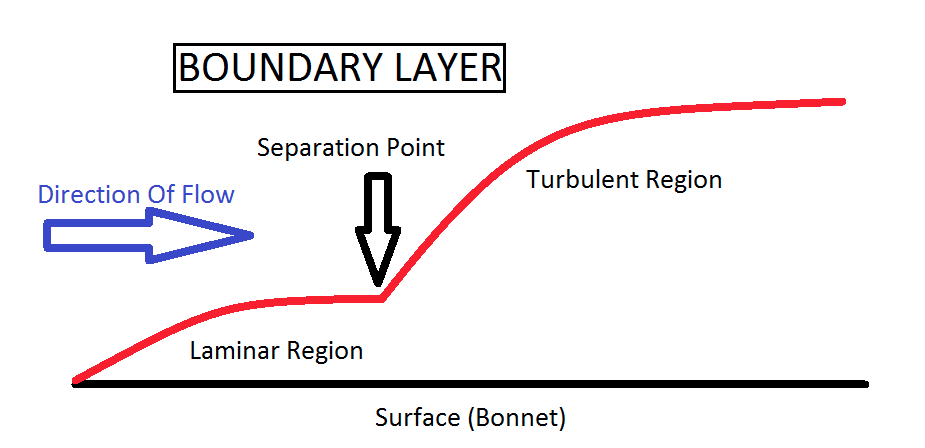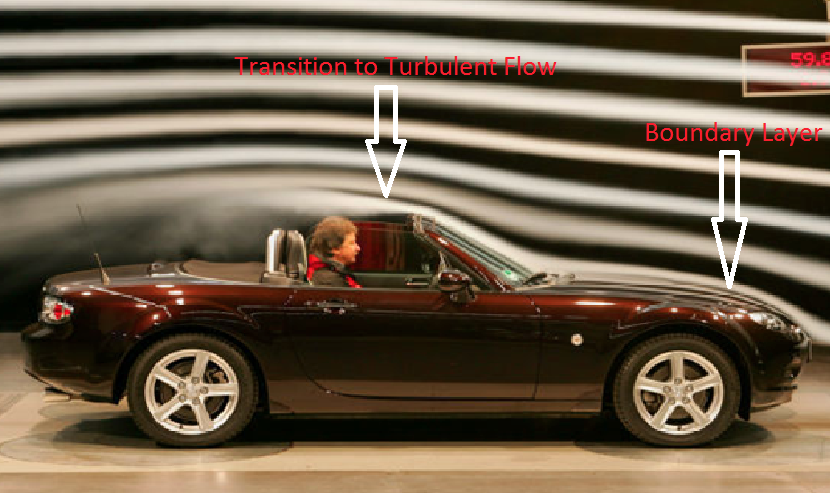Why Does Driving Faster With The Roof Down Keep You Dry?

Alex is happily taking Phil for a spin with the top down in the English countryside, slaloming through the hedgerows and scaring grazing cattle with his constant flexing and screams of turbocharged joy. And then out of nowhere, in swoops Mother Nature and the heavens open. What does he do?
Most sane people would hurriedly pull over but Kersten ain’t got no time for that. So being a car guy, he floors it instead. The question is, can he stay dry by simply driving faster?
The simple answer is yes. Drive above a certain speed threshold and you will stay as dry as a bone, even through the most British of downpours. Even in something like a Mazda MX-5, the basic aerodynamics can negate the need for a roof and allow Alex to let his luscious locks flow, even in the worst of conditions.

The reason for this speed-induced anorak is the presence of something called a boundary layer. A boundary layer is a thin layer of fluid that flows directly above the surface being acted upon, and therefore interacts heavily with that surface.
So in terms of air flow over a car, the boundary layer exists just above the bodywork, flowing over the car’s profile. To understand the effects that this boundary layer has on the fluid flow, we need to delve further into different forms that the air can take as it flows over the car.
There are two generic types of airflow; laminar and turbulent. Laminar is smooth, low-pressure air while turbulent air is high-velocity, high pressure air which swirls erratically. In a boundary layer, as fluid velocity increases, it transitions from being laminar to turbulent at a ‘separation point’. The boundary layer increases in thickness at this point. This means that the cushion of air over the car increases in size once the flow becomes turbulent.

Sliding into the equation now comes the windscreen, the key to keeping Kersten nice and dry. This sharp incline from the bonnet forces the air to accelerate upwards, causing a separation point and therefore a transition into turbulent flow as it reaches the end of the windscreen.

As explained, the air then forms a cushion which safely flows over Alex’s head and dissipates behind the cockpit (as can be seen in the image above). Only at slow speeds will this cushion be minimised due to the decrease in boundary layer thickness, thus allowing for the flow of liquid to enter the cockpit and soak some potentially expensive hair products.
So what is the exact speed needed to stay dry? It depends on the car’s profile, especially the rake of the windscreen. A Miata’s screen is fairly steep and therefore the speed required isn’t too high, somewhere between 50 and 55mph. The steep screen causes the air to become turbulent quickly and increases the thickness of the boundary layer. This means at motorway speeds, you can be sure in the fact that you won’t get caught out with the top down.
Other cars with much shallower windscreens (like a Ferrari Daytona) will naturally create less turbulent air and a thinner boundary layer, forcing the driver to reach a higher speed to stay dry.
So next time you’re caught in the rain in your beloved Miata, S2000 or MR2, just put your foot down!

Comments
Long story short..
https://www.youtube.com/watch?v=6UpmhbPaOHY
I feel like this is pretty well understood and doesn’t really need explaining…
I’ve actually done this with my previous NA mx5. I was coming home from an amusement park in Germany, where it was 28° C. Top down, cruising home (to Belgium) when suddenly it started raining. Quite Heavily. I had to drive 130km/h to stay dry. Everyone was gazing at me like I was some kind of r3tard
Didn’t Mythbusters do something about this?
I dunno.. i find that peeing at a slower speed outside of the car always keeps me drier..
Where as peeing into the wind at high speed tends to cause me and my passenger to get pissed..
people who own a miata won’t take risk to drive in rain cuz HAIRDRESSER
You read the article - no excuses.
Though I am usually bad at understanding physics, this one was well explained. Thank you, mate. So I reckon for my slow cruise driving style, I must dump my Ferrari Daytona and go for a roadster like Miata with a steeper windscreen to stay dry at slow speeds in this unpredictable British rains. I guess, installing a “Windblox” will help me get rid of the turbulence and make my top-down driving much more enjoyable. What do you guys say?
If you are driving fast, then never even think of doing that without mounting a wind deflector lest you will have a hard time dealing with the overwhelming wind noise and buffeting. Thanks to my Windblox windstop I need not yell at my co-passenger even at highway speeds.
Pagination